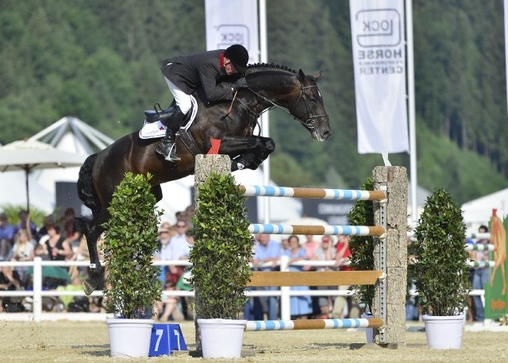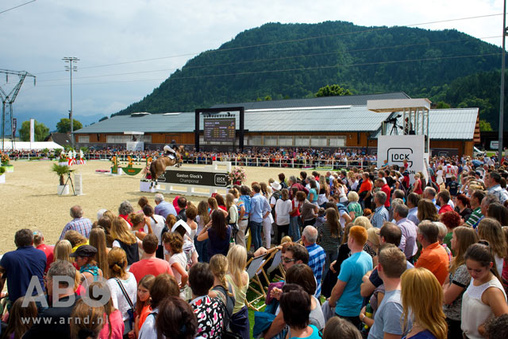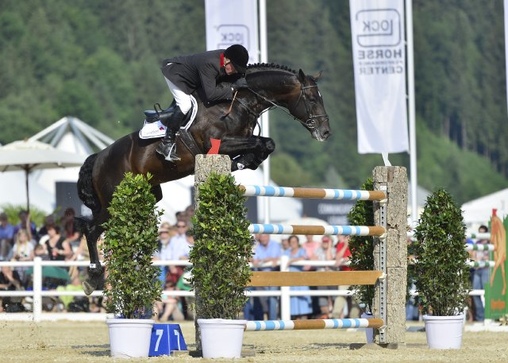 Thursday, 13 August 2015 CSI5* CSI2* CSIYH1* CSIAm-A
Thursday, 13 August 2015 CSI5* CSI2* CSIYH1* CSIAm-AThe artistes of show jumping
Scarcely any type of equestrian sport delights so many fans worldwide as does show jumping. Whether in individual or team competition, on small grounds or in the really large arenas of our world: that symbiosis between horse and rider, jointly overcoming challenging obstacles, and the overwhelming emotions associated with victory and defeat – all these things define what makes show jumping so compelling. But what skills underlie the layout of show jumping courses, what differentiates the many competitions and how do riders pilot their horses through the courses in the optimal way?
Every event, every riding arena and every field of starters presents a new challenge for a course designer. Widely differing dimensions, ground conditions and other influences demand a great deal of knowledge of equestrian sport, and often creativity too, of the responsible persons when laying out courses. All course designers bear a high level of responsibility because, in the context of a tournament, they ultimately decide on the correct level of assistance for both horse and rider, alongside setting the demands for good performance. The show jumping course manager knows both his riders and their horses. Under ideal circumstances, he will promote the best possible development of their skills throughout the days of the tournament from the warm-ups till the finales.
Same heights, various levels of difficulty
The level of difficulty is set according to the category of an event and the class of a competition. This means that a show jumping competition over 1.45 m in the context of a CSI2* tournament is designed differently from one over an equal height but within a 5-star event. Whilst being the same height, the latter would be laid out with a significantly greater level of difficulty. But something true of all competitions is that an ideal show jumping course should not only be visually and technically appealing and good to ride, but also offer spectators the maximum in terms of excitement.
By way of illustration, a course designer can achieve this by combining difficult elements with a variety of demands. For example, in a particular test, towards the end of the course competitors are required to deal with an open water jump followed, just a few canter strides later, by an upright. Whilst the horse must gain speed and extend for the long trajectory over the water, it is then essential to collect before the upright and catch the ideal launch point. A good course designer creates the technical, visual and athletic challenges and applies them with the ideal dimensioning and an appropriate level of consideration for those in his protection.
Technical and visual challenges
In order to know in advance of the ride what obstacles await them in the test, show jumping riders walk the course. This involves seeking out ideal lines, pacing out the distances between jumps and calculating in terms of canter strides. Already here estimates are made of where time can be saved later on. Often one sees competitors discussing whether to ride with more impulsion or more restraint. Because horses have differing canter stride lengths, so one needs to know whether to maybe save one canter stride and ride with more impulsion or let the horse take one more stride but ride correspondingly more restrained. Of course attention is also paid to visual difficulty. The rider must be able to gauge where his horse might “glance”, as it might be susceptible to becoming unsettled by obstacle components. Here colours are less consequential than the type of construction of an obstacle. White poles are hard for horses to weigh up, jumps featuring more empty space with fewer poles and unusual shapes tend to make the animals shy at them.
Calm, gentle training, introducing young horses to new tasks with care and without pressure, is thus the be-all and end-all. Because only if horses have joy in mastering their task can they grow up to become those magnificent competition mounts at which people can marvel at the GHPC.
ABOUT THE GLOCK HORSE PERFORMANCE CENTER
Industrialist Gaston Glock built the GLOCK HORSE PERFORMANCE CENTER for his wife Kathrin and, in 2010, he handed her responsibility for achieving international positioning for this equestrian sports centre. Today not only world champions, Olympic medal holders and European champions but also international show stars are delighted to attend as guests of the Gaston and Kathrin Glock family.
GLOCK Perfection meets equestrian sport
The exclusivity and very special flair of tournaments held at the GLOCK HORSE PERFORMANCE CENTER are internationally renowned and bear the personal signature of the CEO, Kathrin Glock. Here, over a period of four days, not only equestrian sport but also a veritable world of enchantment open up to participants and visitors alike. The breathtaking design of the Riders Lounge, exquisite dining and cocktails, captivating live acts by show stars and moving contributions to charities for people and animals in need.
GLOCK’s Entertainment in the Riders Lounge
With the theme “Horses and Stars”, there’s GLOCK-style high-class entertainment awaiting guests in the exclusive Riders Lounge:
Gourmet entertainment
> Top-class international show acts
> Styling Lounge with star stylist Eren Bektas and his team
> Kids Lounge with creative supervision
> Cinema Lounge for little cinema fans
> Wellness Lounge (manicure, pedicure, massage)
> Dog Wellness – the very finest dog massage with Manfred Kellenc
Day tickets for Thursday, Friday and Sunday available for 300 euros per person.
Day ticket info: +43 664 88 73 44 01
Cooking Lounge
German star chef Alfons Schuhbeck will gain be delighting all in his Cooking Lounge at the GLOCK HORSE PERFORMANCE CENTER. Here, all tournament guests enjoy free entry. The cooking shows take place on Friday and Saturday at 11am, 2pm and 5pm and on Sunday at 11am and 2pm.
Free entry
The tournament arena is accessible to all visitors free of charge. In the Kids Lounge and at the Pony Riding area, fun and entertainment are guaranteed for the youngsters. Dogs have been considered too: in the Dog Lounge there’s plenty of sustenance and the very finest of massages (by appointment and subject to availability) for your faithful pets.
Fully informed
All the information about the competitions, daily summaries, lots of photos and news, along with a live stream and videos of International Show Jumping at the GLOCK HORSE PERFORMANCE CENTER, are all to be found at www.ghpc.at
INFOBOX
What: CSI5* CSI2* CSIYH1* CSIAm-A | International Show Jumping
When: August 27th-30th 2015
Where: GLOCK HORSE PERFORMANCE CENTER Treffen, Villach
VIP day tickets for Thursday, Friday and Sunday: 300 euros per person on +43 664 887 344 01
Free entry to the competition events in the tournament arena
www.ghpc.at

Famous riders with their correspondingly famous horses on the challenging 5-star show jumping course at the GHPC. A highlight for course creators, riders and spectators. © Arnd Bronkhorst

Twice GLOCK’s 5* Grand Prix winner John Whitaker (GBR), with his stallion Argento, mastering a mighty 1.60 m upright. © GHPC / studiohorst
